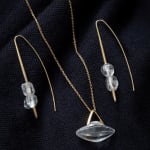

Islamic
Islamic rock crystal pendant necklace and earrings set, Circa 7th - 9th century AD
Rock crystal
Length of earrings: 4.8 cm
Width of pendant: 2.3 cm
Length of chain: 18cm (adjustable to 16cm)
Width of pendant: 2.3 cm
Length of chain: 18cm (adjustable to 16cm)
An ancient Islamic rock crystal bead set into a modern 18 carat gold pendant necklace, with four ancient Islamic rock crystal beads set into a pair of modern 18 carat...
An ancient Islamic rock crystal bead set into a modern 18 carat gold pendant necklace, with four ancient Islamic rock crystal beads set into a pair of modern 18 carat gold earrings.
Provenance
Private collection, UK, acquired in the 1990sLiterature
Rock crystal gems and jewellery were highly sought-after treasures across the Medieval Near East and Europe. This early Islamic rock crystal pendant and beads, which have been carefully set in modern gold fittings, represent a long-standing heritage of Islamic craftsmanship.Rock crystal has been chosen for centuries for its beautiful translucency, its multiple planes, and the fascination of its colours, all of which present themselves differently as light moves around the surface. As a rare medium of art, rock crystal is made of pure quartz crystal, and was shaped by masterful craftsman making it highly valuable.
Belief in the extraordinary properties of rock crystal has persisted since antiquity. The name rock crystal is derived from the Greek word krustallos meaning ‘ice’. Because the material resembles ice the Greeks believed it originated from frozen water. The Romans considered rock crystal a jewel worthy of emperors. According to Pliny the Elder, the mineral’s fragility was proof of its uniqueness. He reveals that vessels made of rock crystal were regarded as some of the most valuable vessels made from semiprecious stone.
‘gold and silver, in fact, became too common. From this same earth we have extracted vessels of murrhine (or myrrhine) and vases of crystal, objects the very fragility of which is considered to enhance their value. In fact, it has come to be looked upon as a proof of opulence, and as quite the glory of luxury, to possess that which may be irremediably destroyed in an instant’.
Pliny the Elder, The Natural History, book 33.3.
Known as ballūr to the ancient Arabs, rock crystal was likely prized for its transparent to white hues, which may have held symbolic significance for its wearers. In early Islam, white was a colour representing purity and benevolence, contributing to the increasing popularity of rock crystal. Likewise, precious stones also held astrological importance, with stars often symbolised by white stones. It is likely the beads in this set originally came from a larger piece of jewellery, made for only the wealthiest in society. For similar examples see The Metropolitan Museum, New York, accession nos. 450855 and 473068.

